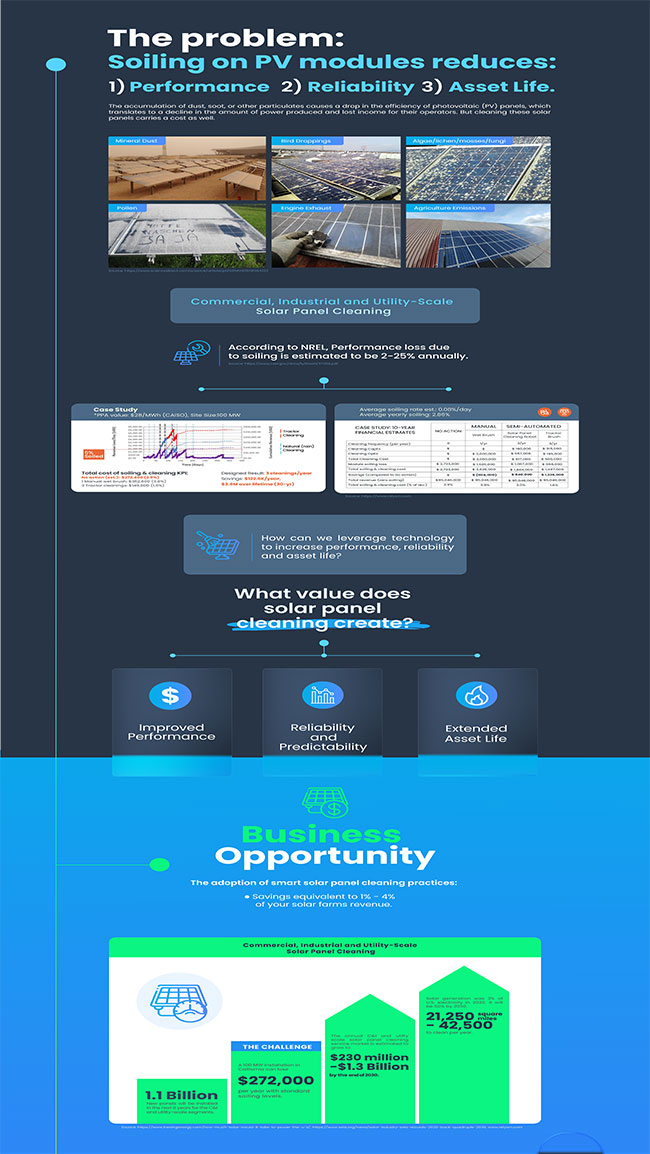PV soiling monitors are one of the best ways to know when solar panel cleaning makes sense from an economic standpoint. By knowing how much performance we are losing and our PPA values we can determine when the cost of cleaning < the cost of being dirty (performance loss).
NextGen PV Soiling Mitigation
Q&A with | Carla Dawson, Founder and CEO of Soilar.tech
Tell us about yourself and Soilar.tech
I founded Soilar Technologies at the beginning of the pandemic in 2019. It became clear to me that solar energy would grow at astronomical rates and that there were opportunities in this segment. As I learned more about the segment, it became clear that PV soiling is a significant problem that needs to be addressed. My background is in industrial and systems engineering so it became natural for me to apply a systems engineering mindset to PV soiling. Soilar Technologies is about using 21st-century technology throughout the PV plant life cycle to solve PV soiling problems. Our solutions are a mix between software, analytics, hardware, and equipment such as solar panel cleaning robotics. Our mission is to help solar panel cleaners, EPC’s, entrepreneurs, PV designers, and performance engineers excel at PV soiling mitigation.
What is NextGen PV soiling mitigation?
Working with Klemens Ilse from the Fraunhofer Institute and Ben Figgis from the Qatar Environment and Energy Research Institute, we felt the term "PV soiling mitigation" was too limited and so the term naturally evolved to “nextgen PV soiling mitigation” which we believe represents the work we do more accurately. Today we define the term like this:
Mitigating photovoltaic soiling by using 21st-century technologies throughout the solar plant lifecycle with the objective of increasing performance, reliability, asset life, and warranty compliance.
NextGen PV Soiling mitigation is typically a data-enriched smart system that combines technologies such as solar panel cleaning robotics, PV anti-soiling coatings, PV abrasion testing, bird deterrent solutions, PV soil monitoring, electrodynamic shields (EDS), condensation prevention, tracker/stowage position, and cleaning schedule optimization, solar panel cleaning software, analytics and other technologies.
Here is a visual representation of how PV soiling mitigation begins in the design & engineering phase and moves through to the O&M Phase
Why is solar panel cleaning important
Solar panel cleaning is important because it represents the first step most asset owners take in the NextGen PV soiling mitigation process. While having clean windows is a “nice to have”, having clean solar panels is a “must-have”. In a perfect world, solar panels would never get dirty and asset owners would never have to fix this problem. However, this world does not exist and the next best thing is NextGen PV soiling mitigation. Solar panel cleaning is important because it is a recurring solution asset owners need to hire throughout the duration of their solar plant's asset life (30 years).
How do you apply technology to solar panel cleaning?
A typical solar farm has 200,000 solar panels and approximately 200,000 square meters to clean 2 - 6 times a year. There are multiple ways to apply technology to solar panel cleaning
PV soiling monitors are one of the best ways to know when solar panel cleaning makes sense from an economic standpoint. By knowing how much performance we are losing and our PPA values we can determine when the cost of cleaning < the cost of being dirty (performance loss). PV soiling monitors are the trigger for calling in the solar panel cleaning service.
By applying automation and semi-automation to solar panel cleaning we can bring down the cost of cleaning and improve the quality of the service level. Solar panel cleaning is very challenging work staying manual is a strategy that will make it uncompetitive. I created the following Guide to Solar Panel Cleaning to help you understand the machinery and robotics in the industry so you can be competitive.
After the panels are clean this value can be seen and calculated via PV soiling monitors and analytics.

.jpg)

Why is it important to adopt technology for solar panel cleaning?
Adopting technology will help your solar installation
-
Improve Performance - Be more productive
-
Improve Reliability - Reliable power output
-
Improve Asset Life - Extend your solar farms asset life by applying quality maintenance
-
Improve Warranty Compliance
Tell us about your book “Introducing The Ultimate Solar Panel Cleaning Book”.
My book compiles more than 2 years of experience, research, insights, and more. The goal of the book is to help EPC’s, solar panel cleaners, entrepreneurs and others accelerate their knowledge about solar panel cleaning. Solar panel cleaning is the first step most people take in PV soiling mitigation. The book consolidates a wealth of knowledge and information on solar panel cleaning. At the moment it only covers solar panel cleaning for the commercial, industrial and utility-scale segments.
The content & opinions in this article are the author’s and do not necessarily represent the views of AltEnergyMag
Comments (0)
This post does not have any comments. Be the first to leave a comment below.
Featured Product

